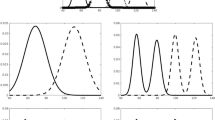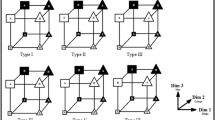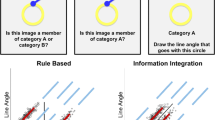Abstract
The traditional supervised classification paradigm encourages learners to acquire only the knowledge needed to predict category membership (a discriminative approach). An alternative that aligns with important aspects of real-world concept formation is learning with a broader focus to acquire knowledge of the internal structure of each category (a generative approach). Our work addresses the impact of a particular component of the traditional classification task: the guess-and-correct cycle. We compare classification learning to a supervised observational learning task in which learners are shown labeled examples but make no classification response. The goals of this work sit at two levels: (1) testing for differences in the nature of the category representations that arise from two basic learning modes; and (2) evaluating the generative/discriminative continuum as a theoretical tool for understand learning modes and their outcomes. Specifically, we view the guess-and-correct cycle as consistent with a more discriminative approach and therefore expected it to lead to narrower category knowledge. Across two experiments, the observational mode led to greater sensitivity to distributional properties of features and correlations between features. We conclude that a relatively subtle procedural difference in supervised category learning substantially impacts what learners come to know about the categories. The results demonstrate the value of the generative/discriminative continuum as a tool for advancing the psychology of category learning and also provide a valuable constraint for formal models and associated theories.






Similar content being viewed by others
Notes
This proposal, while possible, is made less likely when the label is presented before the example, as it is in our experiment.
This task is different from the more prevalent single feature classification task in which a single feature is presented and participants are asked to guess which category is most likely (e.g. Anderson et al. 2002; Hoffman & Murphy, 2006; Murphy & Allopenna, 1994; Rehder, Colner, & Hoffman, 2009; Hayes & Younger, 2004; Ross, 2000).
Because the data was not normally distributed, a Mann-Whitney U test was run instead of the traditional t-test.
Although classification learners had greater overall exposure to each example, they were exposed to the combination of the label and the example for significantly fewer milliseconds (M = 3579, SD = 664) on average than observational learners (M = 4587, SD = 776), t(72) = 6.00, p < 0.001.
As in experiment 1, the Mann-Whitney U test was used because the data was not normally distributed.
As in Experiment 1, although classification learners had greater overall exposure to each example, they were exposed to the combination of the label and the example for significantly fewer milliseconds (M = 3418, SD = 501) than observational learners (M = 4459, SD = 988), t(126) = 7.502, p < 0.001, d = 1.33.
References
Ahn, W., & Medin, D. L. (1992). A two-stage model of category construction. Cognitive Science, 16, 81–121.
Anderson, J. R. (1991). The adaptive nature of human categorization. Psychological Review, 98, 409–429.
Anderson, A. L., Ross, B. H., & Chin-Parker, S. (2002). A further investigation of category learning by inference. Memory & Cognition, 30, 119–128.
Ashby, F. G., Alfonso-Reese, L. A., Turken, A. U., & Waldron, E. M. (1998). A neuropsychological theory of multiple systems in category learning. Psychological Review, 106, 529–550.
Ashby, F. G., Maddox, W. T., & Bohil, C. J. (2002). Observational versus feedback training in rule-based and information integration category learning. Memory & Cognition, 30, 666–677.
Ashby, F. G., Queller, S., & Berretty, P. M. (1999). On the dominance of unidimensional rules in unsupervised categorization. Perceptual and Psychophysics, 61, 1178–1199.
Barsalou, L. W. (1983). Ad hoc categories. Memory & Cognition, 11, 211–227.
Chin-Parker, S., & Ross, B. H. (2002). The effect of category learning on sensitivity to within-category correlations. Memory & Cognition, 30, 353–362.
Chin-Parker, S., & Ross, B. H. (2004). Diagnosticity and prototypicality in category learning: Inference learning and classification learning. Journal of Experimental Psychology: Learning, Memory, and Cognition, 30, 216–226.
Dye, M., & Ramscar, M. (2009). No representation without taxation: The costs and benefits of learning to conceptualize the environment. Sophia: 2nd International Analogy Conference.
Estes, W. K. (1994). Classification and cognition. New York: Oxford University Press.
Goldstone, R. L. (1996). Isolated and interrelated concepts. Memory & Cognition, 24, 608-628.
Goldstone, R. L., Steyvers, M., & Rogosky, B. J. (2003). Conceptual interrelatedness and caricatures. Memory & Cognition, 31, 169–180.
Hayes, B. K., & Younger, K. (2004). Category-use effects in children. Child Development, 75, 1719–1732.
Hoffman, A. B., & Murphy, G. L. (2006). Category dimensionality and feature knowledge: When more features are learned as easily as fewer. Journal of Experimental Psychology: Learning, Memory, and Cognition, 32, 301–315.
Hoffman, A. B., & Rehder, B. (2010). The costs of supervised classification: The effect of learning task on conceptual flexibility. Journal of Experimental Psychology: General, 139, 319–340.
Hsu, A. S., & Griffiths, T. L. (2010). Effects of generative and discriminative learning on use of category variability. Proceedings of the 32nd Annual Cognitive Science Society.
Imai, S., & Garner, W. R. (1965). Discriminability and preference for attributes in free and constrained classification. Journal of Experimental Psychology, 69, 596–608.
Jee, B. D., & Wiley, J. (2007). How goals affect the organization and use of domain knowledge. Memory & Cognition, 35, 837–851.
Kaplan, A. S., & Murphy, G. L. (2000). Category learning with minimal prior knowledge. Journal of Experimental Psychology: Learning, Memory, and Cognition, 26, 829–846.
Kemler Nelson, D. G. (1984). The effect of intention on what concepts are acquired. Journal of Verbal Learning and Verbal Behavior, 23, 734–759.
Kruschke, J. K. (1992). ALCOVE: An exemplar-based connectionist model of category learning. Psychological Review, 99, 22–44.
Kruschke, J. K. (2001). Toward a unified model of attention in associative learning. Journal of Mathematical Psychology, 45, 812–863.
Kruschke, J. K. (2003). Attention in learning. Current Directions in Psychological Science, 12, 171–175.
Kruschke, J. K. (2011). Models of attentional learning. In E. M. Pothos & A. Wills (Eds.), Formal models in categorization (pp. 120–152). Cambridge: Cambridge University Press.
Kruschke, J. K., & Johansen, M. K. (1999). A model of probabilistic category learning. Journal of Experimental Psychology: Learning, Memory, and Cognition, 25, 1083–1119.
Kurtz, K. J. (2007). The divergent autoencoder (DIVA) model of category learning. Psychonomic Bulletin & Review, 14, 560–576.
Little, D. R., & Lewandowsky, S. (2009). Better learning with more error: Probabilistic feedback increases sensitivity to correlated cues in categorization. Journal of Experimental Psychology: Learning, Memory, and Cognition, 35, 1041–1061.
Love, B. C. (2002). Comparing supervised and unsupervised category learning. Psychonomic Bulletin & Review, 9, 829–835.
Love, B. C., Medin, D. L., & Gureckis, T. M. (2004). SUSTAIN: A network model of human category learning. Psychological Review, 111, 309–332.
Markman, A. B., & Ross, B. H. (2003). Category use and category learning. Psychological Bulletin, 129, 592–613.
McKinley, S. C., & Nosofsky, R. M. (1996). Selective attention and the formation of linear decision boundaries. Journal of Experimental Psychology: Human Perception and Performance, 22, 294–317.
Medin, D. L., Altom, M. W., Edelson, S. M., & Freko, D. (1982). Correlated symptoms and simulated medical classification. Journal of Experimental Psychology: Learning, Memory, and Cognition, 8, 37–50.
Medin, D. L., & Schaffer, M. M. (1978). Context theory of classification. Psychological Review, 85, 207–238.
Medin, D. L., Wattenmaker, W. D., & Hampson, S. E. (1987). Family resemblance, conceptual cohesiveness, and category construction. Cognitive Psychology, 19, 242–279.
Minda, J. P., & Ross, B. H. (2004). Learning categories by making predictions: An investigation of indirect category learning. Memory & Cognition, 32, 1355–1368.
Mitchell, T. M. (2010). Generative and discriminative classifiers: Naïve Bayes and logistic regression. In T. M. Mitchell (Ed.), Machine learning. New York: McGraw Hill.
Murphy, G. L. (2002). The big book of concepts. Cambridge: MIT press.
Murphy, G. L. (2003). Ecological validity and the study of concepts. In B. H. Ross (Ed.), The psychology of learning and motivation (Vol. 43, pp. 1–41). San Diego: Academic Press.
Murphy, G. L., & Allopenna, P. D. (1994). The locus of knowledge effects in concept learning. Journal of Experimental Psychology: Learning, Memory, and Cognition, 20, 904–919.
Murphy, G. L., & Medin, D. L. (1985). The role of theories in conceptual coherence. Psychological Review, 92, 289–316.
Murphy, G. L., & Wisniewski, E. J. (1989). Feature correlations in conceptual representations. In G. Tiberghien (Ed.), Advances in Cognitive Science (Theory and applications, Vol. 2, pp. 23–45). Chichester: Ellis Horwood.
Ng, A. Y., & Jordan, M. I. (2001). On discriminative vs. generative classifiers: A comparison of logistical regression and naïve bayes. In Advances in Neural Information Processing Systems, 14.
Nosofsky, R. M. (1984). Exemplar-based accounts of relations between classification, recognition, and typicality. Journal of Experimental Psychology: Learning, Memory, and Cognition, 14, 700–708.
Nosofsky, R. M., Palmeri, T. J., & McKinley, S. C. (1994). Rule-plus-exception model of classification learning. Psychological Review, 101, 53–79.
Pothos, E. M., & Wills, A. J. (Eds.). (2011). Formal approaches in categorization. Cambridge: Cambridge University Press.
Ramscar, M., Yarlett, D., Dye, M., Denny, K., & Thorpe, K. (2010). The effects of feature-label-order and their implications for symbolic learning. Cognitive Science, 34, 909–957.
Rehder, B., Colner, R. M., & Hoffman, A. B. (2009). Feature inference and eye tracking. Journal of Memory and Language, 60, 393–419.
Rehder, B., & Murphy, G. L. (2003). A knowledge-resonance (KRES) model of category learning. Psychonomic Bulletin & Review, 10, 759–784.
Rosch, E. (1978). Principles of categorization. In E. Rosch & B. B. Loyd (Eds.) Cognition and Categorization. Erlbaum: Hillsdale.
Rehder, B. & Hoffman, A. B. (2005). Eyetracking and selective attention in category learning. Cognitive Psychology, 51, 1–41.
Rosch, E., & Mervis, C. B. (1975). Family resemblance: Studies in the internal structure of categories. Cognitive Psychology, 7, 573–605.
Ross, B. H. (1997). The use of categories affects classification. Journal of Memory and Language, 37, 249–267.
Ross, B. H. (1999). Post-classification category use: The effects of learning to use categories after learning to classify. Journal of Experimental Psychology: Learning, Memory, and Cognition, 25, 743–757.
Ross, B. H. (2000). The effects of use on learned categories. Memory & Cognition, 28, 51–63.
Shepard, R. N., Hovland, C. L., & Jenkins, H. M. (1961). Learning and memorization of classifications. Psychological Monographs, 75, 42.
Smith, J. D., & Minda, J. P. (1998). Prototypes in the mist: The early epochs of category learning. Journal of Experimental Psychology: Learning, Memory, and Cognition, 24, 1411–1436.
Solomon, K. O., Medin, D. L., & Lynch, E. (1999). Concepts do more than categorize. Trends in Cognitive Sciences, 3, 99–105.
Vapnik, V. N. (1998). Statistical learning theory. New York: Wiley.
Wattenmaker, W. D. (1991). Learning modes, feature correlations, and memory-based categorization. Journal of Experimental Psychology: Learning, Memory, and Cognition, 17, 908–923.
Yamauchi, T., Love, B. C., & Markman, A. B. (2002). Learning nonlinearly separable categories by inference and classification. Journal of Experimental Psychology: Learning, Memory, and Cognition, 28, 585–593.
Yamauchi, T., & Markman, A. B. (1998). Category learning by inference and classification. Journal of Memory and Language, 39, 124–148.
Author Note
We acknowledge the valuable comments of Greg Murphy and help from Paul Melman and other members of the Learning and Representation in Cognition Lab at Binghamton University, Binghamton, NY, USA.
Author information
Authors and Affiliations
Corresponding author
Appendix
Appendix
Initial instructions for classification learners
“Imagine that a new planet has been discovered in a nearby galaxy. Two types of living creatures have been identified by researchers. These creatures are called: Yugli and Zifer. As part of a student training program, you are being asked to learn about the Yugli and Zifer creatures. Researchers have explored this planet, so pictures of the creatures are now available. You will be shown some pictures in order to learn about the Yuglis and Zifers. TRAINING TASK INSTRUCTIONS: In your training task you will be shown pictures of the creatures one at a time. For each creature, you will decide whether it is a Yugli or a Zifer. You will then be given feedback telling you if you were right or wrong. At first you will not know anything about the two types of creatures, but you will gain experience as you go along. Try your best to learn how to recognize Yuglis and Zifers because you will be tested on your knowledge of them. Good Luck!”
Initial instructions for observational learners
“Imagine that a new planet has been discovered in a nearby galaxy. Two types of living creatures have been identified by researchers. These creatures are called: Yugli and Zifer. As part of a student training program, you are being asked to learn about the Yugli and Zifer creatures. Researchers have explored this planet, so pictures of the creatures are now available. You will be shown some pictures in order to learn about the Yuglis and Zifers. TRAINING TASK INSTRUCTIONS: In your training task you will be shown pictures of the creatures one at a time. Before you see each picture, you will be told whether it is a Yugli or a Zifer. At first you will not know anything about the two types of creatures, but you will gain experience as you go along. Try your best to learn how to recognize Yuglis and Zifers because you will be tested on your knowledge of them. Good Luck!”
Instructions for endorsement task
“Good job! Now that you are familiar with the types of creatures, you will be tested on what you have learned in a number of ways. First, as before, pictures representing creatures will be shown to you. This time, each will come with a statement about whether it is a Yugli or a Zifer. If you agree with the statement, please click “Agree”. If you disagree with the statement, please click “Disagree”. You will not be told whether you are right or wrong.”
Instructions for eliciting typicality ratings
“Now we will show you some pictures of creatures labeled as Yuglis or Zifers. Please rate how good of an example (i.e., typical or representative) each is of the type indicated. An example that you consider typical of its type should be rated high on the scale, while an example that you think is not so typical of its type should be rated low.”
Instructions for single feature inference test
“Next, we will show you pictures of the creatures with one feature missing. We will tell you whether the creature is a Yugli or a Zifer. Please choose which of the two feature options you believe would be most likely.”
Instructions for single feature correlation test
“Now we will show you pictures of the creatures with only one of their features and two possible options for another feature. Please choose which of two feature options would be most likely.”
Rights and permissions
About this article
Cite this article
Levering, K.R., Kurtz, K.J. Observation versus classification in supervised category learning. Mem Cogn 43, 266–282 (2015). https://doi.org/10.3758/s13421-014-0458-2
Published:
Issue Date:
DOI: https://doi.org/10.3758/s13421-014-0458-2




